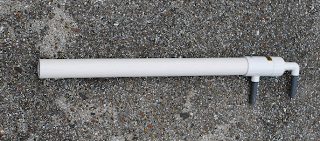My second week at Hatfield Marine Science Center was extremely educational and exciting. This week I went with Dr. Dumbauld to do field work in the upper intertidal zone across the estuary from Hatfield campus. Our goal was to collect a different species of burrowing shrimp known as Neotrypaea gigas or “ghost shrimp” to use for genetic research and the study of how to tell this species from their relatives Neotrypaea californiensis. These samples were harder to get than the mud shrimp Upogebia puttegensis because these N. gigas shrimp are less densely populated. Because of this difference, we used a “slurp gun” (shown below) instead of a big core device with sieve. This gun is placed over the mouths of burrows and then the center rod is pulled to create suction and suck the water (and hopefully shrimp) out of the burrow. The burrows of this species are very convoluted which means there are a lot more places to hide. This explains why after three hours we only ended up with eleven shrimp!
During the rest of this week I also helped deconstruct a wet lab experiment that Katelyn Bosley had set up to monitor the effects of water temperature on shrimp metabolism and growth. The many biotic—living—and abiotic—non-living—factors that affect the growth of burrowing shrimp make the sizes of same-aged shrimp extremely variable, which makes the alternate aging methods so important. I also spent time in the lab measuring the carapace length for “recruits” of the other species of ghost shrimp Neotrypaea californiensis. This data could be used to observe changes in the size of young populations over several years. A view of the Upogebia puttegensis burrows can be seen below.
Next week I hope to begin surveying the population of Upogebia puttegensis at several locations in the Yaquina Bay estuary to assess how the population may be fluctuating. I also hope to begin collecting samples of both species of shrimp to see if the aging of the eye stalks is a viable technique.


Looking forward to seeing how well the eye stalk method compares to the lipofuscin method.
ReplyDeleteSo am I. Hopefully these structures will be viable and then I can test both techniques on the same shrimp!
ReplyDelete